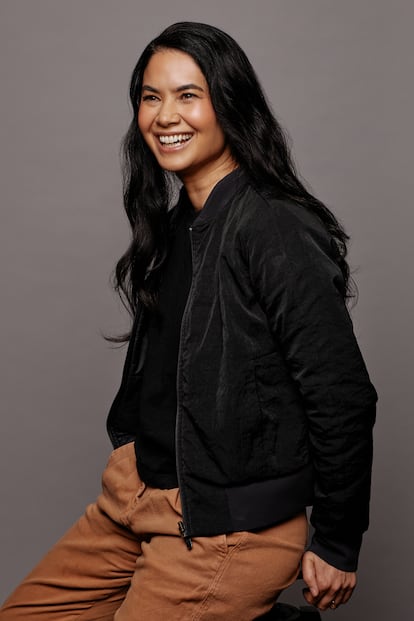Melanie Perkins, CEO of Canva: ‘With AI, we’re going into another era. We need to adapt’
The leader of the world’s most popular all-in-one graphic design platform is one of the few women at the helm of a multibillion-dollar technology company


When she was 20 years old, Melanie Perkins taught graphic design at a university, wishing simpler tools were available. All that they had in 2008 were complicated programs that required skills that almost no one had. Thinking of solving a small problem, she launched, in her mother’s living room and with her then-boyfriend – now husband – Cliff Obrecht, an online and collaborative yearbook design company that proved to be very successful in her native Australia. However, her dream was yet to come true. It took more than a hundred “no”s from Silicon Valley investors before she made her breakthrough in 2013, when she finally raised the capital to launch Canva. A decade later, 130 million people use her technology every month to make social media posts, birthday cards, resumes, edit photos and videos, create web pages and more; a list that continues to grow in the most popular free all-in-one graphic design platform in the world. The latest addition is the integration of the Flourish data visualization tool.
With more than 15,000 million designs produced in 190 countries, the company known as Australia’s golden child has a strong presence in the Americas and wants to become established in Europe. Currently, 16% of its users are located there; they plan to double this figure in the coming years. Although Canva could not escape the economic recession that affected technology companies last year — it has lost 44% of its market value — it has been able to resist the wave of massive layoffs that companies like Meta and Paypal have faced. “We’ve been profitable and we’re continuing to grow rapidly. One of the things that we’ve invested in very heavily is ensuring that we have a free product and a paid product that’s affordable. As the macroeconomic climate has changed, people are actually turning to Canva. All these factors have allowed us to continue to invest in our team, to continue to grow our team, but in that very mindful manner that we have been doing for a number of years,” says Perkins to EL PAÍS from her new London office.
In many ways, she is the exception. First, because she is one of the few women who leads a technology company. Second, because the company has a market valuation of $25.6 billion, according to the venture capital firm Blackbird. And she achieved all of this before turning 35. Until last year she was also the second richest woman in her country, and has promised to donate her fortune. Although many analysts attribute Canva’s success to her leadership, she doesn’t usually take the credit; she doesn’t like to talk about gender, either. When asked if she has been underestimated for being a woman, she nods in agreement, but she doesn’t bring herself to utter the word “yes.” She prefers to answer the questions in the plural and credits the team, their experience, their exciting way of doing business and a long-term strategic vision. “We’ve been investing in AI for a number of years,” she says.
Question. Canva was already betting on artificial intelligence before the boom. Did you see this impact coming in the creative sector?
Answer. Our whole thing at Canva is to enable people to take their idea, turn into a design and have no friction between those two points. That’s been our mission for the last decade. Now we can take all these different things, integrate them into one platform and make it accessible to everyone. AI has been a really important part of that for us for many years. For example, to have a background removed with one click, which has been used 1.8 billion times across the world. Being able to take more of the world’s best technology, that’s been rapidly accelerating, and integrate it.
Q. A lot of content creators or designers are frightened by the speed at which generative artificial intelligence is taking hold. What would you tell them?
A. Something that was in our pitch deck more than a decade ago was that, with the latest technology, the industry has been transformed every few decades, and that’s been going on forever. When desktop computers were born, desktop publishing came into existence. And then with the internet a whole new mode of creation was born. And now, with AI, we’re going into another era. Every time technology comes, we need to adapt. We need to learn how to navigate it, to utilize it to help us to achieve our goals. Trying to embrace the latest in technology, trying to ensure that it becomes part of our workflow and that it enables us to be more productive and it supercharges us, I think is extraordinarily important.
Q. Is the AI revolution similar to previous ones?
A. Yes. And we need to continue to embrace the latest technology, continue to be able to supercharge our workforce.
Q. Has the arrival of ChatGPT affected Canva’s plans?
A. The rate of acceleration in the industry has dramatically increased, but it’s been in this trajectory for a while. So if you look back, that rate of acceleration of technology in the AI and generative AI spaces has been extraordinarily exciting to see. And for us, it just enables us to give way more magical powers to our community.
Q. What is your position on regulation?
A. We have been incredibly careful and cautious, overly cautious, in fact. We have a large trust and safety team and we have ensured that things like the political and medical, and a lot of these areas, can’t be addressed inside Canva, as far as Magic Write [a content generating tool] goes, because we think there’s just so much unknown at this point in time, and so much that needs to be figured out. And so we sort of sidestep those things inside our product. There are other companies pioneering in that space, and there’s a lot that needs to happen, but we wanted to ensure that wasn’t happening inside Canva.
Q. You have shown that you do business with passion and a human touch. How do you manage not to lose that when a company like yours grows in size?
A. I feel like throughout the journey, there’s constantly a fork in the road: go and do something that feels authentically Canva, or do something just as another company has done it. The more that we bring our fun and our values and things that feel authentic, the better it is. We’ve had our little road. Was it silly and quirky? Yes. It was fun. The more we do that as a team, the more we dream big dreams together and then will them into existence.
Q. Is it difficult to maintain authenticity when thousands of employees and their families depend on the company?
A. It’s critical to put people first. When you look at large numbers, you can get lost in it. But actually, with the products, I ask myself, is it good enough for my family and friends? If it’s not good enough for them, it’s not good enough for anyone. And we want to create a company that we want to work at. So we try to make sure that every decision that we are making is in line with that.
Q. As a woman, have you ever felt like your capabilities were underestimated?
A. We faced a lot of rejection. I can’t really attribute it to one specific thing, but we didn’t really tick any of the standard boxes.
Q. Is it harder for women to succeed in the tech world?
A. I think that the rejection was kind of good for me, in that it meant that I got very, very sure of what I wanted to do and very convinced of our vision. Having our first company that was bootstrapped was extraordinarily important, because it meant that we would have to a profitable company. We put on every single hat under the sun, from marketing to sales to customer service. Going through that entire process was extraordinarily important.
Q. Have you ever thought that it would have been easier had you not been a woman?
A. Some investors may have looked at founders from the past and thought that those are the boxes that a founder must tick. Hopefully Canva’s success has opened up what that means. What a founder could look like, where a founder could be from or a founder’s background.
Q. What is your advice to girls and women who want to become part of the tech world?
A. It’s really important to find a problem that you care passionately about. We always dream of the future that we want to will into existence, and then we work very hard towards that. That’s really important, on a personal level, it’s really important on a team level, and on a company and country level, in fact. I think that the basic formula of “dream something and turn into a reality” is critically important.
Q. With the integration of increasingly powerful artificial systems, are you afraid that the human perspective will be lost?
A. I like to say all people, at least most people, want to live on a planet where people have access to basic human rights; where everyone can afford to eat and everyone can afford to have a roof over their heads and access to health care. I think that’s the future I want to work towards building into existence.
Sign up for our weekly newsletter to get more English-language news coverage from EL PAÍS USA Edition
Tu suscripción se está usando en otro dispositivo
¿Quieres añadir otro usuario a tu suscripción?
Si continúas leyendo en este dispositivo, no se podrá leer en el otro.
FlechaTu suscripción se está usando en otro dispositivo y solo puedes acceder a EL PAÍS desde un dispositivo a la vez.
Si quieres compartir tu cuenta, cambia tu suscripción a la modalidad Premium, así podrás añadir otro usuario. Cada uno accederá con su propia cuenta de email, lo que os permitirá personalizar vuestra experiencia en EL PAÍS.
¿Tienes una suscripción de empresa? Accede aquí para contratar más cuentas.
En el caso de no saber quién está usando tu cuenta, te recomendamos cambiar tu contraseña aquí.
Si decides continuar compartiendo tu cuenta, este mensaje se mostrará en tu dispositivo y en el de la otra persona que está usando tu cuenta de forma indefinida, afectando a tu experiencia de lectura. Puedes consultar aquí los términos y condiciones de la suscripción digital.
More information
Últimas noticias
Welcome to the post-religion era: The idea of Christianity as the absolute truth has become obsolete
‘I thought you would like it’: The risky sexual practice popularized by TV shows and TikTok
The digitalization of tourism: ‘They promise experiences and gave us the worst possible one’
Mexican peso defies uncertainty with forecasts of a new period of stability in 2026
Most viewed
- Sinaloa Cartel war is taking its toll on Los Chapitos
- Reinhard Genzel, Nobel laureate in physics: ‘One-minute videos will never give you the truth’
- Oona Chaplin: ‘I told James Cameron that I was living in a treehouse and starting a permaculture project with a friend’
- Why the price of coffee has skyrocketed: from Brazilian plantations to specialty coffee houses
- Silver prices are going crazy: This is what’s fueling the rally










































